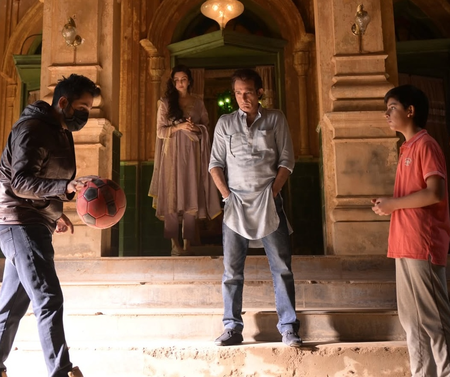
Mumbai, March 3 (IANS) It is sad how ill-informed our media is! The coverage of the passing away of legendary ghazal singer, Pankaj Udhas, demonstrates this lack of information and research.
The credit for Pankaj’s fame is attributed mainly to one film song, ‘Chitthi aayee hai…’ from ‘Naam’. The film was released in 1986 by which time Pankaj had become a hugely popular ghazal singer, second only to the veteran Jagjit Singh. But then, Jagjit Singh had a head start.
By 1986, Pankaj had quite a few silver, gold and platinum discs to his credit. These discs were awarded by the music companies on an album achieving a certain milestone in sales. Ghazals were initially a choice of certain discerning music lovers.
But Pankaj had a varied repertoire and his numbers such as ‘Ghungroo toot gaye’, ‘Sharab cheez hi aisi hai’, ‘Chandi jaisa rang’ and ‘Niklo na benaqab’ carried a definite appeal for the masses. That explained his all-round popularity and those platinum, gold and silver discs he earned.
For the true-blue ghazals and the ones with mass appeal, which Pankaj had included in his repertoire, he needed to cultivate a market. The film music scene was too formidable in those days for a parallel taste in music to grow.
Music India Limited probably sensed the need for music other than those from films. They signed promising singing talents such as Talat Aziz, Anup Jalota, Bhupinder and Mitali, Penaz Masani, Rajendra and Neena Mehta, and Pankaj Udhas.
The music company did something unique to promote its artistes. A two-night sit-down ghazal festival, Khazana, was organized at the Taj Mumbai. And the invitees were the elite of Mumbai.
The Khazana Fest was such a hit that the music company decided to follow it up on a more ambitious scale the following year, taking it to more metros. Starting in Mumbai, the Khazana went to Delhi, Kolkata, Bengaluru and Hyderabad.
As I write this and think back, the applause of the audience still rings in my ears. In fact, in Kolkata, the audience consisting of men and women and families, demanded that Khazana continue till dawn by the time it would be safe to be on the road.
A new breed of ghazal singers had arrived. The best part was that, for the tour was announced well in advance, the singers were welcomed with front-page pictures and coverage in newspapers and magazines before they arrived.
All these singers created their own following but Pankaj went on to become the star, thanks to his sober nature, pleasant attitude, and the choice of numbers and velvety voice with which he rendered his numbers.
Soon, he was performing in programmes all over India and abroad.
Pankaj and his two brothers, Manhar and Nirmal, made for a unique singer-brother trio. The Udhas brothers come from the Charan community of the Saurashtra region of Gujarat; music and poetry was in their blood.
The community was honoured in the courts of the rulers in the region as they were known to conjure up songs of valour in times of war or victory or praise of a brave heart in an instant. Not surprising that all three brothers, Manhar, Nirmal and Pankaj were gifted singers and musicians.
As what usually happens after the death of such a celebrity, I am sure most of Pankaj’s fans are now surfing the Net and YouTube and playing his numbers. That is the best tribute we can pay to him.
It’s All About Admission Rates
The reduced admission rate — a flat Rs 99 — introduced by major multiplex managements on February 23 did prove one thing and that is, the audience is not shy of coming to a cinema. And that affords them a chance to decide for themselves if a film is good or not. They do not have to count on paid or biased social media influencers to decide.
The people who take in a film on Day One are the people who ensure a film has a better chance for a sustained run. The opinions of the people who watch a film and then comment are more trusted than others.
Their comments on social media as well as in person to friends and family are constant. In my previous column, I had suggested that if the cinema chains rationalised admission rates, it certainly would be like old times when people, those who are called compulsive first-day-first-show movie buffs, could afford to do so.
Give people a chance to come to the cinema and they will decide what film they like. Nobody says people like all films released on a weekend. I am proved right when I compare the two films released this past Friday, ‘Article 370’ and ‘Crakk’.
Even if the opening days are made affordable, people will come to watch a film and they will be the real ambassadors for films, for people no longer believe in either social media or media reviews, and the four and five stars that they bestow on films.
And then, on social media, there are always two sides, those who do the filmmaker or star’s bidding for a consideration and those who are genuine movie buffs who share true reviews.
An example is the recent Gujarati release, ‘Kasoombo’. A trade analyst who usually posts about Hindi films has claimed that this Gujarati film has collected Rs 2.36 crore in the first week and Rs 3.9 crore in its first 10 days, which he describes as “WOW!!”.
But this claim contradicts the figures carried on his official website, where the collections add up to about Rs 80 lakh-plus! And some netizens have noticed and pointed out the contradiction between the two. What drives such social media posts? Anybody’s guess!
The first-day-first-show audience is not the kind to be taken for granted. Film lovers have their instincts about a film so they flock to see one film but ignore another! A film they are not convinced about is not seen on OTT either. So, even in the old days, some films with big stars drew the crowds and other films starring the same stars found no takers.
This happened in the Rajesh Khanna era and with Amitabh Bachchan. He had ‘Zameer’ between two hits, ‘Deewaar’ and ‘Chupke Chupke’, and ‘Faraar’ between ‘Sholay’ and ‘Kabhi Kabhie’.
Take the example of Rajesh Khanna’s peak period, when he was doing hit films such as ‘Daag’, ‘Namak Haraam’, ‘Aap Ki Kasam’, and ‘Prem Nagar’. He came up with a flop in ‘Ajnabee’ and an arty film, ‘Aavishkar’ — it was not the kind of film his audience wanted to see him in. This happens with all actors, none barred.
A filmmaker often hoped that even if the audience did not turn up in the first show of the first day, people would come eventually. Towards this end, it was a practice for the producer to buy tickets and distribute them for free. The idea was to make the cinema house-full and get those who attended the show to talk about the film.
People believed in word of mouth, so, a number of films that would open on a weak note, gradually picked up and went on to become big hits. This usually happened with the social films produced by Rajshri Pictures or Prasad Productions, and often with many Hindi films from the South.
With the terms the cinemas offered in those days, it was possible to give a film enough leeway to buy that time. The cinemas charged a rent in those days. Now, as a result of the box office sharing system, the cinemas don’t like to continue a film for nothing if it is not collecting enough.
But with reasonable admission rates, a good film may just sustain another film that may not be liked as much by the audience. Ttalking about the two films of the last week, ‘Article 370’ and ‘Crakk’, the Cinema Lovers Day on February 23, which was also the opening day of the films, helped. Both films managed a decent opening day figure, counting in crores, which otherwise would have been in lakhs.
‘Article 370’ opened with Rs 6 crore, thanks to the Rs 90 admission rate and ‘Crakk’ collected Rs 4 crore. ‘Article 370’ was appreciated, so it went on to make Rs 9 crore the next day and Rs 10 crore on Sunday.
This was possible because of the positive reports from the audience on Day One. ‘Crakk’, on the other hand, could not sustain and fell to Rs 2 crore after an opening of Rs 4 crore. None of the two films would have collected even these figures at the normal admission rates.
This is what public reports do to films. These are a kind of exit poll. Unlike the social media reviews, nobody pays people to say good things about a film. They pay to watch a film and express their views honestly.
It is strange that the theatre managements know what cinema lovers want –seven days a week of admission rates that is easy on their pocket — yet they just don’t wish to rationalise their prices.
–IANS
vinod/srb




